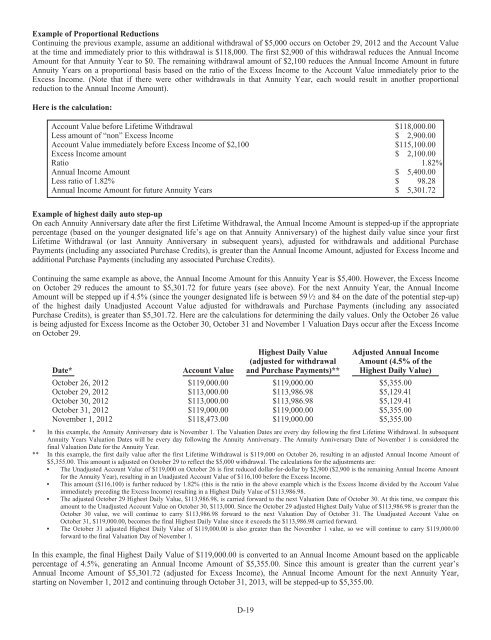Prudential Premier Retirement Variable Annuities
Prudential Premier Retirement Variable Annuities
Prudential Premier Retirement Variable Annuities
Create successful ePaper yourself
Turn your PDF publications into a flip-book with our unique Google optimized e-Paper software.
Example of Proportional Reductions<br />
Continuing the previous example, assume an additional withdrawal of $5,000 occurs on October 29, 2012 and the Account Value<br />
at the time and immediately prior to this withdrawal is $118,000. The first $2,900 of this withdrawal reduces the Annual Income<br />
Amount for that Annuity Year to $0. The remaining withdrawal amount of $2,100 reduces the Annual Income Amount in future<br />
Annuity Years on a proportional basis based on the ratio of the Excess Income to the Account Value immediately prior to the<br />
Excess Income. (Note that if there were other withdrawals in that Annuity Year, each would result in another proportional<br />
reduction to the Annual Income Amount).<br />
Here is the calculation:<br />
Account Value before Lifetime Withdrawal $118,000.00<br />
Less amount of “non” Excess Income $ 2,900.00<br />
Account Value immediately before Excess Income of $2,100 $115,100.00<br />
Excess Income amount $ 2,100.00<br />
Ratio 1.82%<br />
Annual Income Amount $ 5,400.00<br />
Less ratio of 1.82% $ 98.28<br />
Annual Income Amount for future Annuity Years $ 5,301.72<br />
Example of highest daily auto step-up<br />
On each Annuity Anniversary date after the first Lifetime Withdrawal, the Annual Income Amount is stepped-up if the appropriate<br />
percentage (based on the younger designated life’s age on that Annuity Anniversary) of the highest daily value since your first<br />
Lifetime Withdrawal (or last Annuity Anniversary in subsequent years), adjusted for withdrawals and additional Purchase<br />
Payments (including any associated Purchase Credits), is greater than the Annual Income Amount, adjusted for Excess Income and<br />
additional Purchase Payments (including any associated Purchase Credits).<br />
Continuing the same example as above, the Annual Income Amount for this Annuity Year is $5,400. However, the Excess Income<br />
on October 29 reduces the amount to $5,301.72 for future years (see above). For the next Annuity Year, the Annual Income<br />
Amount will be stepped up if 4.5% (since the younger designated life is between 59 1 ⁄2 and 84 on the date of the potential step-up)<br />
of the highest daily Unadjusted Account Value adjusted for withdrawals and Purchase Payments (including any associated<br />
Purchase Credits), is greater than $5,301.72. Here are the calculations for determining the daily values. Only the October 26 value<br />
is being adjusted for Excess Income as the October 30, October 31 and November 1 Valuation Days occur after the Excess Income<br />
on October 29.<br />
Date* Account Value<br />
Highest Daily Value<br />
(adjusted for withdrawal<br />
and Purchase Payments)**<br />
Adjusted Annual Income<br />
Amount (4.5% of the<br />
Highest Daily Value)<br />
October 26, 2012 $119,000.00 $119,000.00 $5,355.00<br />
October 29, 2012 $113,000.00 $113,986.98 $5,129.41<br />
October 30, 2012 $113,000.00 $113,986.98 $5,129.41<br />
October 31, 2012 $119,000.00 $119,000.00 $5,355.00<br />
November 1, 2012 $118,473.00 $119,000.00 $5,355.00<br />
* In this example, the Annuity Anniversary date is November 1. The Valuation Dates are every day following the first Lifetime Withdrawal. In subsequent<br />
Annuity Years Valuation Dates will be every day following the Annuity Anniversary. The Annuity Anniversary Date of November 1 is considered the<br />
final Valuation Date for the Annuity Year.<br />
** In this example, the first daily value after the first Lifetime Withdrawal is $119,000 on October 26, resulting in an adjusted Annual Income Amount of<br />
$5,355.00. This amount is adjusted on October 29 to reflect the $5,000 withdrawal. The calculations for the adjustments are:<br />
▪ The Unadjusted Account Value of $119,000 on October 26 is first reduced dollar-for-dollar by $2,900 ($2,900 is the remaining Annual Income Amount<br />
for the Annuity Year), resulting in an Unadjusted Account Value of $116,100 before the Excess Income.<br />
▪ This amount ($116,100) is further reduced by 1.82% (this is the ratio in the above example which is the Excess Income divided by the Account Value<br />
immediately preceding the Excess Income) resulting in a Highest Daily Value of $113,986.98.<br />
▪ The adjusted October 29 Highest Daily Value, $113,986.98, is carried forward to the next Valuation Date of October 30. At this time, we compare this<br />
amount to the Unadjusted Account Value on October 30, $113,000. Since the October 29 adjusted Highest Daily Value of $113,986.98 is greater than the<br />
October 30 value, we will continue to carry $113,986.98 forward to the next Valuation Day of October 31. The Unadjusted Account Value on<br />
October 31, $119,000.00, becomes the final Highest Daily Value since it exceeds the $113,986.98 carried forward.<br />
▪ The October 31 adjusted Highest Daily Value of $119,000.00 is also greater than the November 1 value, so we will continue to carry $119,000.00<br />
forward to the final Valuation Day of November 1.<br />
In this example, the final Highest Daily Value of $119,000.00 is converted to an Annual Income Amount based on the applicable<br />
percentage of 4.5%, generating an Annual Income Amount of $5,355.00. Since this amount is greater than the current year’s<br />
Annual Income Amount of $5,301.72 (adjusted for Excess Income), the Annual Income Amount for the next Annuity Year,<br />
starting on November 1, 2012 and continuing through October 31, 2013, will be stepped-up to $5,355.00.<br />
D-19

















